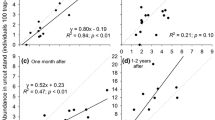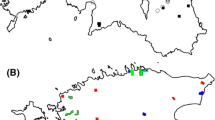Abstract
In this paper, we present a model for source–sink population dynamics where the locations of source and sink habitats change over time. We do this in the context of the population dynamics of the North American red squirrel, Tamiasciurus hudsonicus, within a forest environment subject to harvesting and regrowth. Harvested patches of forest are initially sinks, then eventually become source habitat again as the forest regrows. At the same time, each harvested patch is gradually recolonized by squirrels from other forest patches. We are interested in the interaction of forest harvesting dynamics with squirrel population dynamics. This depends on the harvesting schedule, and on the choices squirrels make when deciding whether to settle in a mature forest patch or in a recently harvested patch. We find that the time it takes for a second-growth forest patch to be recolonized at the mature forest level is longer than the time required for the habitat quality to be restored to the mature forest level. We also notice that recolonization pressure decreases squirrel populations in neighbouring patches. The connectivity between forest patches and the cutting schedule used also affect the time course of recolonization and steady-state population levels.
Similar content being viewed by others
References
Amarasekare, A., Possingham, H., 2001. Patch dynamics and metapopulation theory: The case of successional species. J. Theor. Biol. 209, 333–344.
Banks, T., Beck, B., Beck, J., Todd, M., Bonar, R., Quinlan, R., 1999. Red squirrel winter food and cover: Habitat suitability index model version 5. Online: http://www.fmf.ca/HS/HS_report20.pdf.
Bayne, E., Hobson, K., 2000. Relative use of contiguous and fragmented boreal forest by red squirrels (Tamiasciurus hudsonicus). Can. J. Zool. 78(3), 359–365.
Becker, C.D., Boutin, S., Larsen, K.W., 1998. Constraints on first reproduction in North American red squirrels. Oikos 81, 81–92.
Berteaux, D., Boutin, S., 2000. Breeding dispersal in female North American red squirrels. Ecology 81(5), 1311–1326.
Boutin, S., Larsen, K.W., Berteaux, D., 2000. Anticipatory parental care: Acquiring resources for offspring prior to conception. Proc. R. Soc. Lond. B 267, 2081–2085.
Buenau, K.E., Gerber, L.R., 2004. Developing recovery and monitoring strategies for the endemic mount graham red squirrels (Tamiasciurus hudsonicus grahamensis) in Arizona. Anim. Conserv. 7, 17–22.
Canadian Council of Forest Ministers, 1998. Size of clearcuts by ownership and by province for the latest period calculated. Online: http://www.for.gov.bc.ca/hfp/forsite/jtfacts/3-1j-can-clear.htm.
Donahue, M.J., Holyoak, M., Feng, C., 2003. Patterns of dispersal and dynamics among habitat patches varying in quality. Am. Nat. 162(3), 302–317.
Foppen, R.P.B., Chardon, J.P., Liefveld, W., 2000. Understanding the role of sink patches in source–sink matapopulations: Reed warbler in an agricultural landscape. Conserv. Biol. 14(6), 1881–1892.
Fretwell, S.D., Lucas, Jr., H.L., 1970. On territorial behavior and other factors influencing habitat distribution in birds. I. Theoretical development. Acta Biotheor. 19, 16–36.
Gilpin, M., Hanski, I., 1991. Metapopulation Dynamics: Brief History and Conceptual Domain. Academic Press, London.
Gundersen, G., Johannesen, E., Andreassen, H.P., Ims, R.A., 2001. Source–sink dynamics: How sinks affect demography of sources. Ecol. Lett. 4, 14–21.
Hanksi, I., Gilpin, M., 1997. Metapopulation Biology: Ecology, Genetics and Evolution. Academic Press, London.
Haughland, D.L., Larsen, K.W., 2004. Exploration correlates with settlement: Red squirrel dispersal in contrasting habitats. Ecology 73(6), 1024–1034.
Keagy, J.C., Schreiber, S.J., Cristol, D.A., 2005. Replacing sources with sinks: When do populations go down the drain? Restor. Ecol. 13(3), 529–535.
Kimmins, J.P, 2003. Forest Ecology: A Foundation for Sustainable Management, 3rd edn. Macmillan, New York.
Krebs, C.J., Boutin, S., Boonstra, R. (Eds.), 2001. Ecosystem Dynamics of the Boreal Forest: The Kluane Project. University of Oxford Press, New York.
Larsen, K., 2007. Dispersal activity of North America red squirrels (Tamiasciurus hudsonicus) in varying-aged forest stands. Can. J. Zool., submitted for publication.
Larsen, K., Boutin, S., 1995. Exploring territory quality in the North American red squirrel through removal experiments. Can. J. Zool. 73, 1115–1122.
Larsen, K.W., Boutin, S., 1994. Movements, survival, and settlement of red squirrel (Tamiasciurus hudsonicus) offspring. Ecology 75(1), 214–223.
Larsen, K.W., Boutin, S., 1998. Sex-unbiased philopatry in the North American red squirrel (Tamiasciurus hudsonicus). In: Steel, M.A., Merritt, J.F., Zegers, D.A. (Eds.), Ecology and Evolutionary Biology of Tree Squirrels. Virginia Museum of Natural History, Martinsville, VA, pp. 21–32.
Levins, R., 1970. Extinction. In: Gerstenhaber, M. (Ed.), Some Mathematical Problems in Biology. Symposium on Mathematical Biology. American Mathematical Society, Providence, RI, pp. 77–107.
Murray, J.D., 2003. Mathematical Biology. II: Spatial Models and Biomedical Applications. Springer, New York.
Nathan, R., Perry, G., Cronit, J.T., Strand, A.E., Cain, M.L., 2003. Methods for estimating long-distance dispersal. Oikos 103, 261–273.
Obbard, M.E., 1987. Red squirrel. In: Wild Furbearer Management and Conservation in North America. Ontario Ministry of Natural Resources, Ontario, Canada, pp. 265–281.
Okubo, A., Levin, S.A., 2001. Diffusion and Ecological Problems: Modern Perspectives. Springer, New York.
Pickett, S.T.A., White, P.S., 1985. The Ecology of Natural Disturbances and Patch Dynamics. Academic Press, New York.
Pulliam, H.R., 1988. Sources, sinks and population regulation. Am. Nat. 132(5), 652–661.
Pulliam, H.R., Danielson, B.J., 1991. Sources, sinks, and habitat selection: A landscape perspective on population dynamics. Am. Nat. 137, S50–S66.
Rushton, S.P., Lurz, P., Fuller, R., Garson, P.J., 1997. Modelling the distribution of the red and grey squirrel at the landscape scale: A combined gis and populations dynamics approach. J. Appl. Ecol. 34, 1137–1154.
Stacey, P.B., Ligon, J.D., 1987. Territory quality and dispersal options in the acorn woodpecker, and a challenge to the habitat-saturation model of cooperative breeding. Am. Nat. 130(5), 654–676.
Thomas, C.D., Kunin, W.E., 1999. The spatial structure of populations. J. Anim. Ecol. 68, 647–657.
Travis, J.M.M., French, D.R., 2000. Dispersal functions and spatial models: Expanding our dispersal toolbox. Ecol. Lett. 3, 163–165.
van Dooren, T.M.J., Matthysen, E., 2004. Generalized linear models for means and variances applied to movements of tiger beetles along corridor roads. J. Anim. Ecol. 73, 261–271.
Watkinson, A.R., Sutherland, W.J., 1995. Sources, sinks and pseudo-sinks. J. Anim. Ecol. 64(1), 126–130.
Author information
Authors and Affiliations
Corresponding author
Rights and permissions
About this article
Cite this article
Nyquist, B., Tyson, R. & Larsen, K. Modelling Recolonization of Second-Growth Forest Stands by the North American Red Squirrel Tamiasciurus hudsonicus . Bull. Math. Biol. 69, 1311–1339 (2007). https://doi.org/10.1007/s11538-006-9160-2
Received:
Accepted:
Published:
Issue Date:
DOI: https://doi.org/10.1007/s11538-006-9160-2




